How to Convert CSV to vCard on Mac, Windows & Online
 20.6K
20.6K
 3
3
CSV (with the extension .csv) is a common format that can be used to store different types of data, such as contact information. vCard (with the extension .vcf) is a format dedicated to storing contacts.
Although both are widely supported, some services or apps, such as iCloud, only accept vCard. Therefore, if you want to import contacts to such a service or app from a CSV file, a conversion is needed.
In this article, I will show you how to easily convert CSV to vCard on computers and phones using four different tools, providing step-by-step instructions and tips for achieving successful conversions.
 Cisdem ContactsMate
Cisdem ContactsMate
The Best CSV to vCard Converter
- Import contacts from CSV and vCard
- Convert contacts to vCard and other formats (such as CSV, Excel, etc.)
- Provide accurate conversion and high compatibility
- Support various contacts sources: Google, Outlook, Mac's Contacts, iCloud (Mac only), etc.
- Let you view, search, edit, create, group, tag, share, print and sync contacts
- Find and fix duplicate contacts and formatting issues (such as incomplete names, phone numbers in wrong formats, etc.)
- Help you easily convert contacts between formats
 Free Download macOS 10.11 or later
Free Download macOS 10.11 or later  Free Download Windows 10 or later
Free Download Windows 10 or later
Check your CSV file before conversion: Why it’s important and how to do it
If the contact information in a CSV file is not properly organized, a CSV to vCard converter tool may not accept the file in the first place, or some contact information may be missing or incorrect in the vCard that converted from your CSV file. Therefore, it can be important to check the file first.
To check and edit your CSV file for a successful conversion, first open the file in a spreadsheet app like Microsoft Excel and then do the following:
- Check for missing headers: The first row in your CSV file should be the headers (i.e., the name of each column, such as Name) instead of actual contact information. Missing all or some headers can cause the conversion to fail. You can add headers as needed.
![a CSV file opened in Excel, showing contact information, along with headers like Name, Company and Phone]()
- Check for wrong headers: Check if a header matches the information in this column. For example, don’t use Name as the header for the phone number column. Also make sure that you use common headers. For example, use Name instead of FullName. Correct any mistakes you find.
- Check for other issues: You can also delete duplicate contacts or the empty columns if you like, which is not essential.
Additional Info:
When converters handle a CSV file, a process called field mapping is essential, which makes sure each piece of contact information (such as the name) is in the right place. Field mapping and the later conversion will fail if your CSV file doesn’t have headers or if the file uses wrong headers.
A comparison of 4 tools for converting CSV to vCard
I tested a number of popular CSV to vCard converters with the same CSV file containing 650 contacts. After that, I tried to import the converted vCards to iCloud, iPhone, and Google Contacts respectively to test compatibility. Based on the test results, I chose the best four converters.
Here’s a comparison of the four converters to help you quickly find the tool that suits you.
| Converters | Work on | Converted vCard version | Compatible with | ||
|---|---|---|---|---|---|
| Google Contacts | iCloud | iPhone | |||
| Cisdem ContactsMate | Mac, Windows | 3.0 | Yes | Yes | Yes |
| Mac's Contacts | Mac | 3.0 | Yes | Yes, but with data missing | Yes |
| Windows Contacts | Windows | 2.1 | Yes | No | Yes |
| fileconverts.com | Mac, Windows, Android, iPhone | 3.0 | Yes | No | Yes |
Note:
There are three versions of vCard: 2.1 (outdated but still supported by many), 3.0 (the most popular) and 4.0 (the most advanced but not as widely supported as 3.0). If a converted vCard is not accepted by a certain app or service, it may have something to do with the version or the converter used, among other reasons.
How to convert CSV to vCard on Mac
The vCard format is well supported on Mac. In this part, I will share two tools for Mac users to do the conversion.
Use Cisdem ContactsMate
Cisdem ContactsMate, which is a professional contact manager app that supports both old and new macOS versions, can help Mac users easily and effectively get the conversion done. Here's why.
- Turn a CSV file with one or multiple contacts into a vCard
- Convert multiple CSV files to a single vCard
- Provide accurate conversions, with complete and organized contact information
- Provide high compatibility, with vCards being supported by iCloud, iPhone, Google Contacts, and more
- Easy to use for everyone
Below are the steps.
1. Download and install ContactsMate on your Mac.
2. When you open it for the first time, click OK in the message that appears.
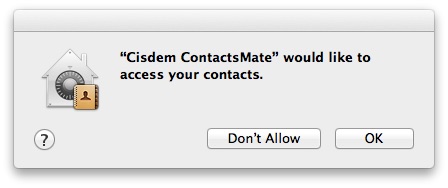
3 In the left sidebar, right-click (control-click or two-finger tap) On My Mac and then choose New Group.
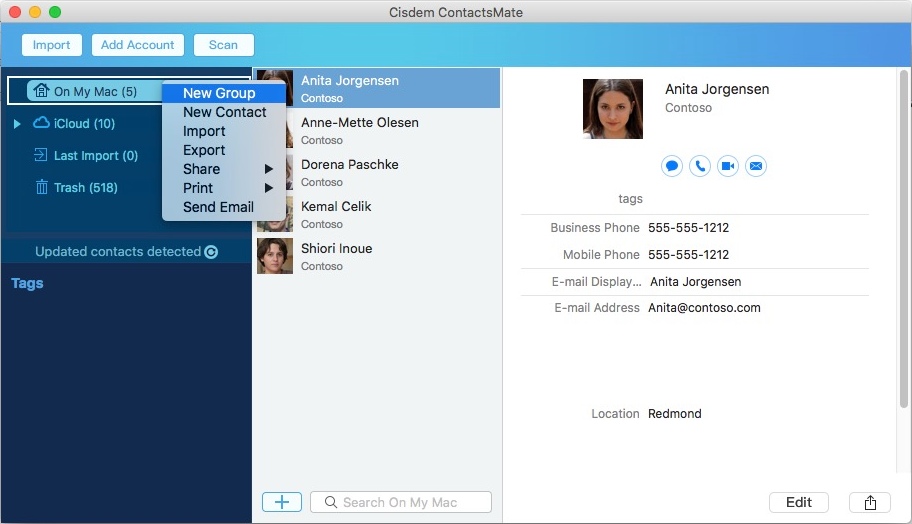
4. Right-click New Group and then choose Import. Import the CSV file that you want to convert.
5. In the Field Mapping Selection dialog that appears, manually make adjustments if needed and click OK.
Note:
ContactsMate has already performed automatic field mapping to help make sure that each field (such as the name or email) in the converted vCard matches the correct column in your CSV file.
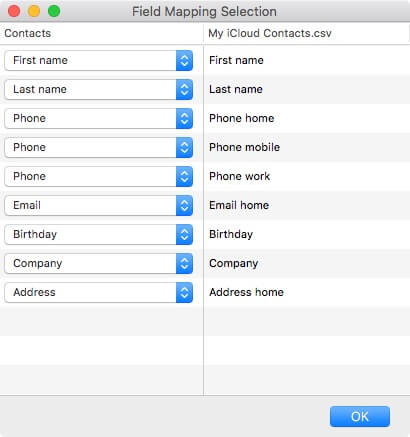
6. Right-click New Group and then choose Export.
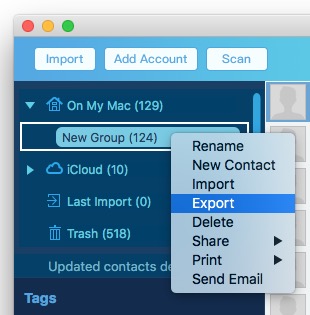
7. In the conversion dialog that appears, select vCard from the Format menu and click Save.
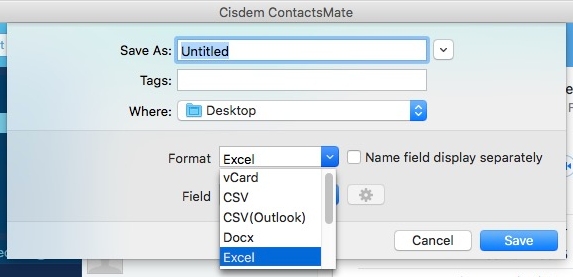
Now you will see a .vcf file on your desktop.
(To delete the contacts imported into ContactsMate from the CSV file, click New Group in the sidebar, select all contacts in this group with Command-A, press the Delete key, and confirm by clicking Delete in the pop-up that appears.)
Use Mac’s Contacts app
Your Mac comes with an app called Contacts (formerly Address Book), which can help you get the conversion done. However, in the test where I imported the converted vCard to iCloud, the address information was missing. Also, it may not be that convenient to use because you need to back up your current contacts first.
1. Open the Contacts app on your Mac.
2. From the Contacts menu bar, choose File > Export > Contacts Archive.
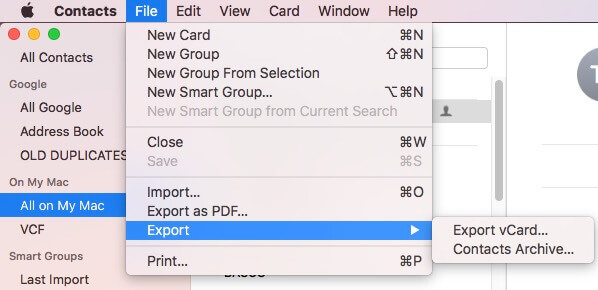
3. Delete all the contacts.
4. From the Contacts menu bar, choose File > Import.
5. Select the CSV file you wish to convert and click Open.
6. Optionally, customize the automatic field mapping if necessary. Click OK.
7. From the Contacts menu bar, choose File > Export > Export vCard.
8. Delete all the contacts.
9. Import the archive file exported in step 2.
How to convert .csv to .vcf on Windows PC
This part features two tools to help Windows users do the conversion.
Use Cisdem ContactsMate
Cisdem ContactsMate is a contact management app available for Mac and Windows. If you use Windows 11 or 10 and have a Google or Outlook account, you can use this app for the conversion.
1. Download and install ContactsMate.
 Free Download Windows 10 or later
Free Download Windows 10 or later
2. Open the app. Add your Google or Outlook account.
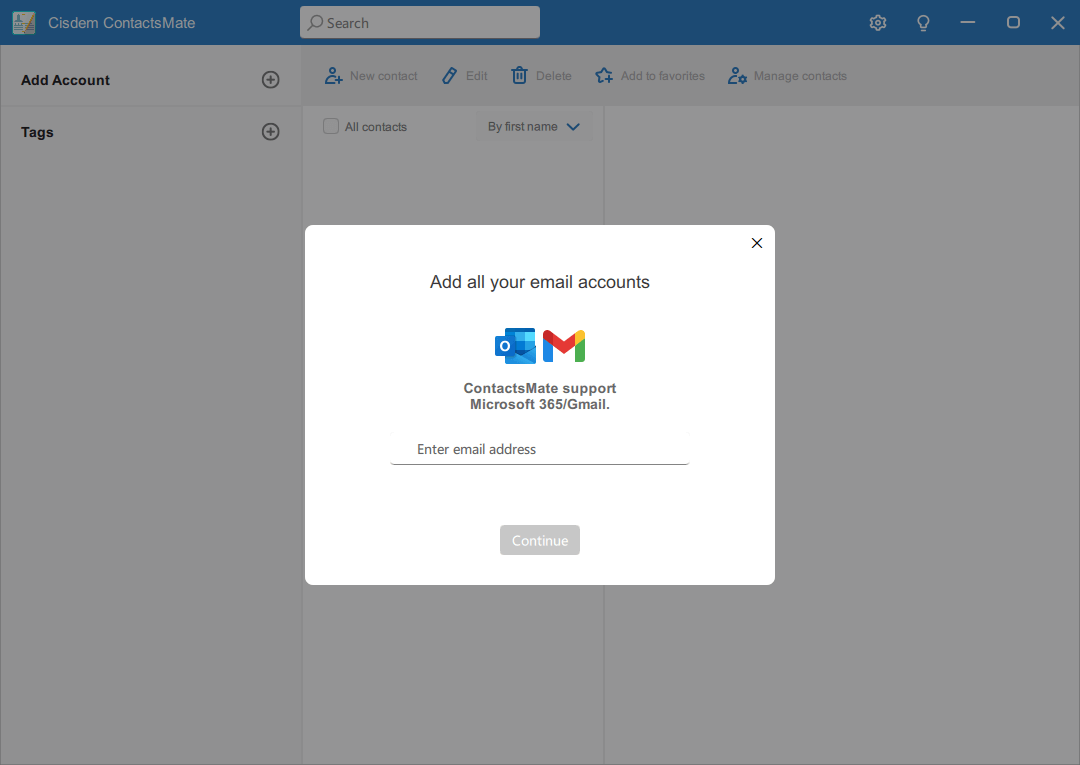
3. Click Manage contacts in the top right corner and choose Import contacts.
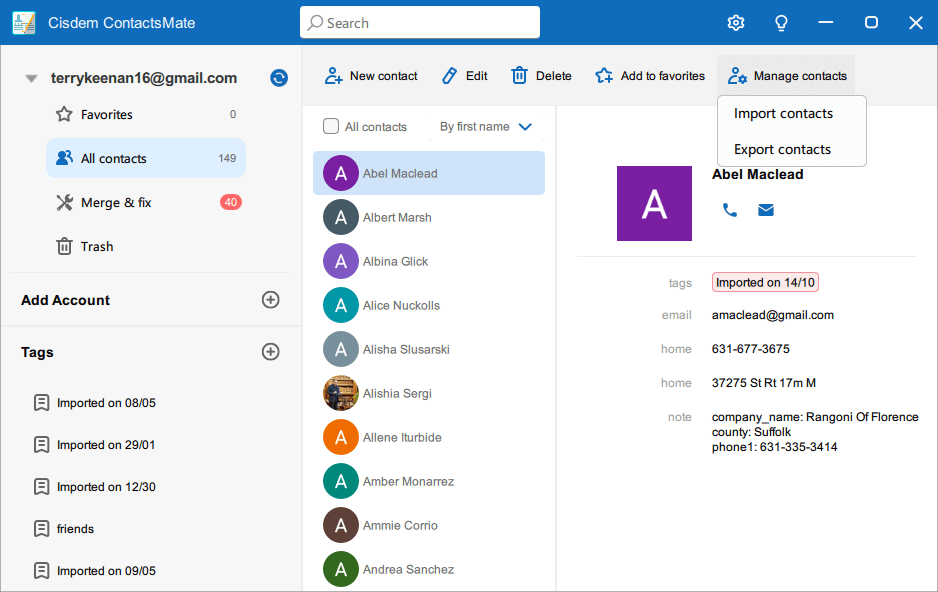
4. In the Import contacts dialog, click Label > New Tags and create a tag called Convert. Now click Browse to import your CSV file.
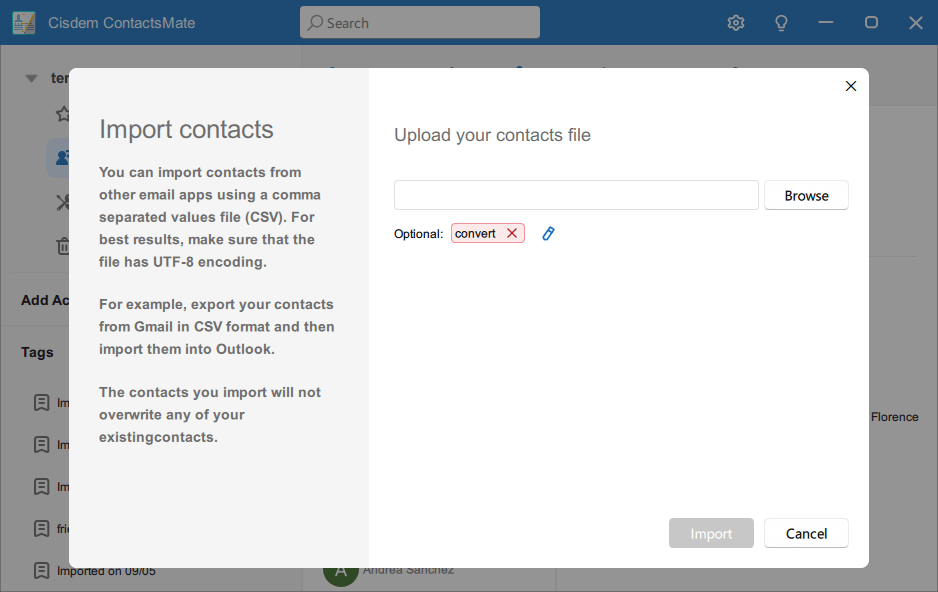
5. In the left sidebar's Tags section, click Convert. Select all contacts under this tag.
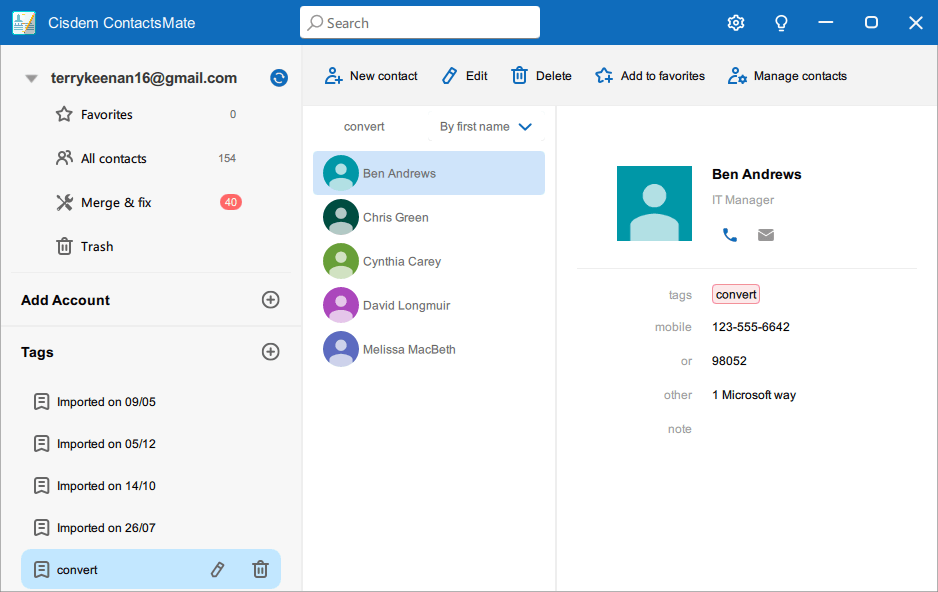
6. Click Manage contacts > Export contacts.
7. In the dialog that appears, choose Selected contacts in the Contacts from this folder menu, and choose vCard in the Export as menu. Click Export.
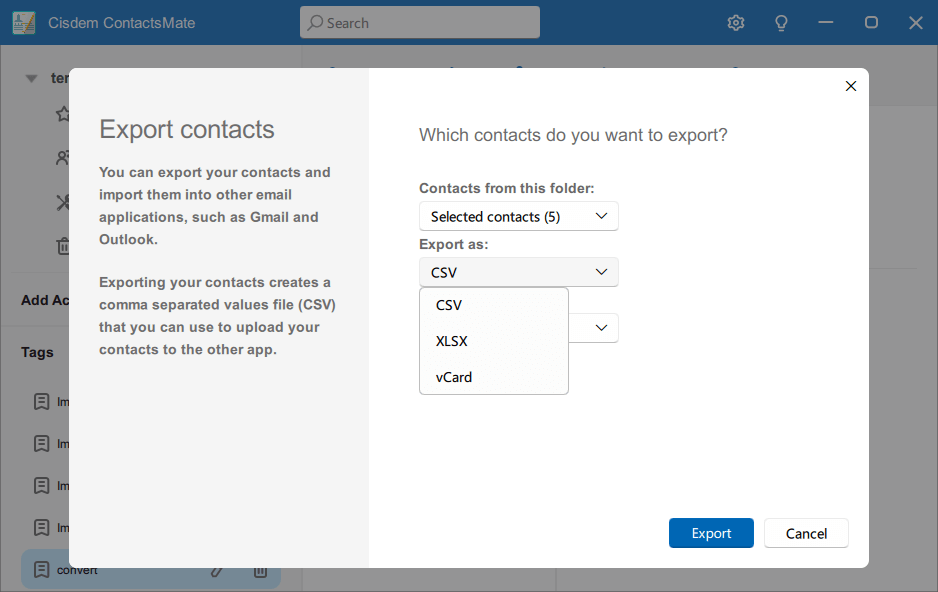
Use Windows Contacts
Windows 11, 10, 8, 7, or Vista has a built-in contact manager called Windows Contacts. It can help you convert contacts between formats and supports a few formats, including CSV and vCard.
With this tool, you will get one vCard if your CSV file contains only one contact. If the CSV has, for example, 50 contacts, you will get 50 individual .vcf files. If you prefer to have all converted contacts in a single vCard, you need to merge those .vcf files into one.
1. In the search box on the taskbar, type “wab.exe”.
2. Click the “web.exe Run command” result, which will open Windows Contacts.
3. Click the Import option in the toolbar. If you can’t see this option, click the arrow icon to find it.
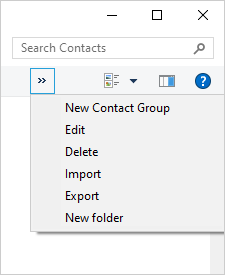
4. In the Import to Windows Contacts dialog, choose CSV (Comma Separated Values) and click Import.
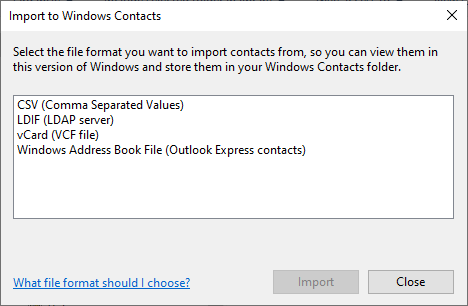
5. In the CSV Import dialog, import your CSV file and click Next.
6. In the Map the fields you wish to import section, adjust the automatic field mapping if needed. Click Finish. Now Windows Contacts is displaying all the contacts stored in the CSV file.
7. Create a new folder on your desktop.
8. In the toolbar, click the Export option.
9. In the Export Windows Contacts dialog, choose vCards (folder of .vcf files) and click Export.
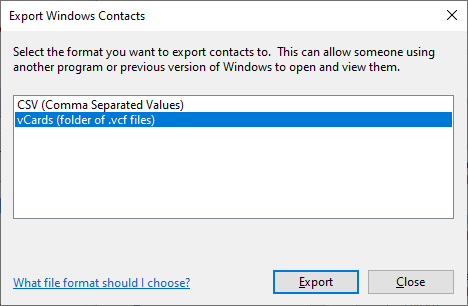
10. In the Browse For Folder dialog, select Desktop and then the folder created in step 7.
11. Once the conversion is complete, go to the new folder to find the .vcf files.
How to do the conversion using an online converter
Using online converters is another common way for converting contacts between different formats. Such online tools are easily accessible and usable. Since they run on a web browser, they are available for Mac, Windows, Android, and iPhone.
I tested four online CSV to vCard converters. Here’s a comparison of them based on my experience.
| Online converter | Converted vCard version | Details | Advice |
|---|---|---|---|
| thewebvendor.com | 3.0 |
|
Not recommended |
| coolutils.com | 3.0 |
|
Not recommended |
| phrogz.net | 3.0 |
|
Not recommended |
| fileconverts.com | 3.0 |
|
Recommended |
Use fileconverts.com
Among those online CSV to vCard converters, I chose fileconverts.com. This tool is easy to use and customizable enough and supports relatively large CSV files.
Online tool fileconverts.com is dedicated to converting files between different formats. It’s free to use and supports tons of formats including .csv and .vcf. It’s easy to use and customizable enough and supports relatively large CSV files.
1. In a browser on your Mac, Windows, PC, iPhone, Android device, visit fileconverts.com/csv/csv-to-vcard/.
2. Click Choose CSV File and upload the CSV file that you want to convert.

3. Optionally, click the CSV Input Options dropdown menu to customize settings as needed. Leave them as default unless the customization is really needed.
4. Click Process. The vCard Options section will appear, allowing you check the automatic field mapping. Manually map CSV columns to corresponding vCard fields if needed.
5. When the conversion is complete, click Save to download the .vcf file to your device.
The conversion may take some time for large CSV files.
FAQ
How do I convert a CSV file to vCard?
You can use a contact management app like ContactsMate, the built-in contacts app coming with your computer’s operating system, or an online tool.
How do I check the vCard version?
If you fail to import the converted vCard to a service or app, you can try checking if the vCard version is the one that you need. Open the vCard with TextEdit on your Mac (or Windows Notepad on a PC) and then look for “VERSION”.
Can you change vCard 3.0 to 4.0?
vCard 3.0 is currently the most widely supported version, but some apps may need the 4.0 version. To change the version, you can try using a text editor to replace “VERSION:3.0” to “VERSION:4.0”. However, if the modified vCard isn’t well supported by a service or app, or if you are concerned about compatibility, you can use a dedicated version converter.
To wrap up
Converting a CSV file with contact information to a vCard can be an easy task, since there are many tools available. However, it can be tricky sometimes. If your CSV file lacks some essential content like headers, or if the CSV file is disorganized, the conversion may fail. Therefore, checking your CSV file before conversion can help you improve efficiency. Among the tools discussed in this article, you can choose the one that best suits your needs.

With a passion for tech and writing, Sarah joined Cisdem, where she focuses on creating articles about using utility tools to enhance file management and simplify contact management.

Adrian Li is Cisdem’s Chief Engineer and serves as the editorial advisor for Duplicate Finder and ContactsMate. His work and insights have been featured in leading tech publications such as Fossbytes, TUAW, Redmond Pie, SafetyDetectives, and BestForAndroid.




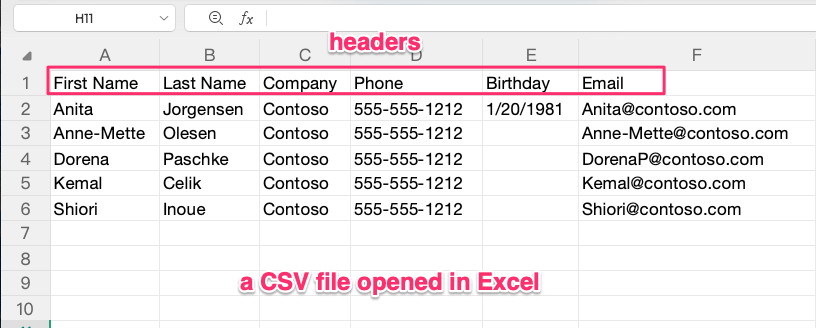
Reibnitz
This guide helped me convert a CSV file with over 500 contacts into vCard without any hassle. Great!
Heyes
Just wanted to drop a quick comment to say thank you. The step-by-step instructions were spot-on, and I appreciate the inclusion of multiple methods. I tried Method 1 and was happy with how easy it was. Keep up the excellent work!
Real Person
I searched for what seemed like forever to find a solution for converting my Yahoo contacts to iCloud. I looked at free and paid versions and nothing worked until I downloaded this Cisdem ContactsMate software. I used the free version and was able to convert almost 150 contacts successfully. 11/10!!